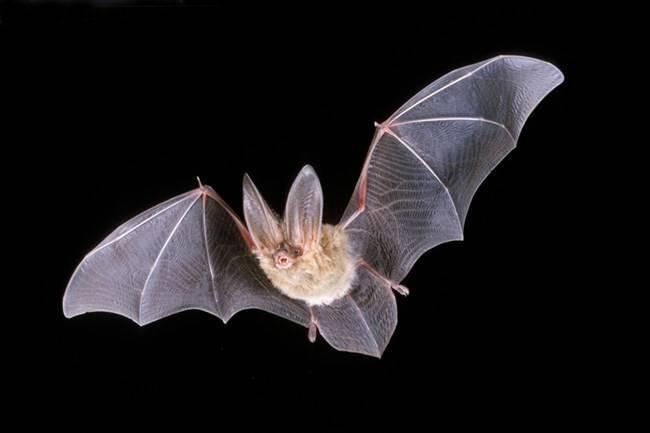
President* Trump built his 2016 campaign on a pledge to bring back coal jobs. That promise has yet to materialize in force, primarily due to competition from natural gas, wind power and solar power. To make matters worse for coal communities, ever since Inauguration Day the President's own Department of Energy (DOE) has been vigorously pursuing policies that help drive down the cost of renewable energy.
In the latest development, DOE is launching a new round of $6 million in funding for research that helps lower the cost of wind power while also avoiding impacts on wildlife, particularly bats and whales.
The road to bat-friendly wind power (and whales, too)
Triple Pundit has previously taken note of the disconnect between the President's coal friendly rhetoric and the wind-friendly actions of his own Department of Energy.The new $6 million initiative falls neatly into that frame. It comes from from the Wind Energy Technologies Office (WETO), which is tasked with investing in projects that "lower wind energy costs, increase capacity, accelerate reliable and safe energy production, and address environmental and human use considerations."
The new initiative seeks proposals in three areas, each of which will get a $2 million share of the $6 million pot.
The first area is aimed at fine tuning wind farms to operate more efficiently without increasing the impact on bat species.
Many wind farms already practice such "curtailment regimes," but the new generation of taller, bigger wind turbines presents some efficiency challenges. On the plus side, the larger turbines enable wind farms to be built in areas with less-than-ideal wind speeds. The tradeoff, though, is that curtailment regimes will have an outsized effect on power production, making those wind farms less efficient.
WETO anticipates that new "smart" technology will make it more economical to locate wind farms in low-speed areas.
In a related effort, the second area addresses some shortcomings in previous attempts to reduce bat impacts. WETO is looking for proposals that develop early-stage research to the next level, or that provide design solutions to resolve performance gaps that it has identified.
The third area drifts off the bat topic to provide more insights into the impacts of offshore wind farms, particularly impacts that may affect Northern Atlantic right whales. This area seeks to improve monitoring at offshore sites, which present a suite of challenges:
...the lack of fixed platforms, increased difficulties associated with survivability offshore, access for maintenance or data downloading, and availability of electric power all make required studies more difficult and more expensive.
Another focus of this area is to create new tools for reducing noise at offshore construction sites.
If all goes according to plan, the new research will lead to improvements in site selection and construction methods, promoting more efficiency in the environmental review process.
Vigorous support for wind power, from the Trump administration?
All else being equal, anticipating and resolving impacts on aquatic life will help accelerate offshore wind development in the US.
That's not exactly a reassuring thought for the U.S. coal industry.
Also not helping matters is DOE's insistence on maintaining a robust web page for climate change, which clearly identifies power production and fossil fuels as the main drivers.
It's not hard to find. Just go to the top of the energy.gov home page, click on "Science & Innovation" (right next to the big green "ENERGY.GOV" block), and go to Climate Change in the dropdown menu.
The page leads off with a mission statement that places climate change in the context of other responsibilities maintained by the sprawling agency:
Addressing the effects of climate change is a top priority of the Energy Department.
The page also forcefully affirms the scientific consensus on climate change, with the help of a user-friendly "Climate Change IQ" quiz.
Take the quiz (spoiler alert!) to see where the US coal industry fits in:
Electricity production generates the largest share of U.S. greenhouse gas emissions. About 66 percent of our nation's electricity comes from burning fossil fuels, mostly coal and natural gas. Renewable energy sources provide 13 percent of U.S. electricity, while nuclear power provides about 20 percent...
Although U.S. Energy Secretary Rick Perry has regularly accommodated White House efforts to support the coal industry, so far he has failed to produce any concrete results.
That seems to be a purposeful outcome. Last year's notorious "grid study," for example, failed to convince the federal rate-making body, FERC, to prop up aging coal power plants with an unusual new rate structure.
Adding insult to injury, the grid study actually made a better case for wind power -- and it did nothing to hamper Perry's ongoing promotion of the U.S. wind industry.
The White House followed up last April with an order for DOE to invoke its emergency authority to prop up coal power plants. As with the grid study, Perry supported the order in public, but probably nothing will come of it.
So far, Perry has slow-walked the advance work needed to act on the directive.
That's probably a good strategy. By June, FERC officials were already shooting down the idea that the recent rash of coal power plant closures justifies emergency action.
Photo: U.S. National Parks Service.

Tina writes frequently for TriplePundit and other websites, with a focus on military, government and corporate sustainability, clean tech research and emerging energy technologies. She is a former Deputy Director of Public Affairs of the New York City Department of Environmental Protection, and author of books and articles on recycling and other conservation themes.














